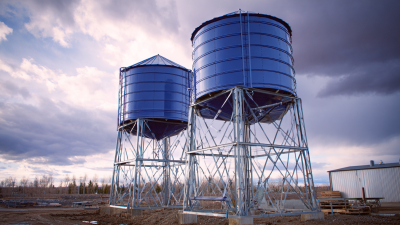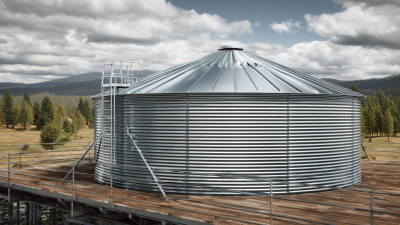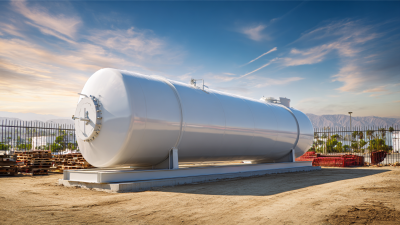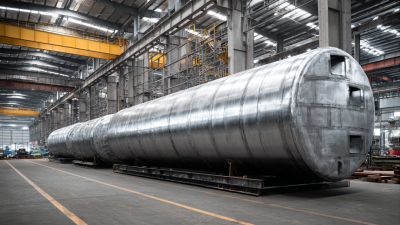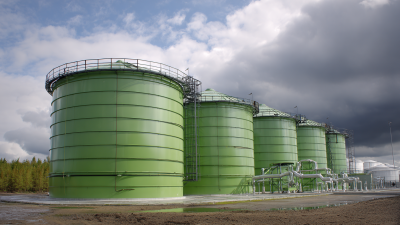In the ever-evolving landscape of facility management, the implementation of efficient and innovative solutions is paramount, particularly concerning fire safety measures. The importance of Fire Water Storage Tanks is underscored by industry reports highlighting that over 50% of fire-related property damage can be attributed to inadequate water supply during emergencies. Modern facilities require advanced storage systems that not only meet regulatory standards but also enhance overall safety efficiencies. According to the National Fire Protection Association (NFPA), facilities that utilize optimized fire water storage solutions experience a 30% reduction in response time during fire incidents. As organizations strive to balance safety and operational efficiency, understanding the latest technologies and practices surrounding Fire Water Storage Tanks becomes essential for safeguarding assets and ensuring compliance.
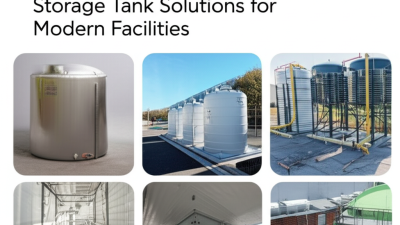
Innovative technologies in fire water storage tank design are transforming how modern facilities manage their fire protection systems. The latest advancements focus on materials and structure that enhance durability, reduce maintenance costs, and optimize water supply. For instance, research shows that tanks made of composite materials can extend service life by up to 30% compared to traditional steel tanks, tackling issues like corrosion and structural weaknesses effectively. Moreover, smart water monitoring systems integrated into these tanks help facilities maintain optimal water levels and quality, significantly minimizing the risk of fire hazards.
Tip: Consider using modular tank designs, which allow for flexible scaling according to your facility's needs. This approach not only maximizes space but also ensures that your fire protection system can adapt to future demands without extensive renovations.
Additionally, energy-efficient heaters and insulation technologies for fire water storage tanks have gained traction, enabling facilities to maintain water temperature effectively during extreme weather conditions. Reports indicate that implementing these energy-efficient solutions can lead to a 25% reduction in energy costs. By prioritizing innovative designs, facilities can ensure their fire water storage systems contribute to overall emergency preparedness and sustainability goals.
Tip: Regularly assess and upgrade your fire water storage systems to incorporate the latest technologies, ensuring optimal performance and compliance with industry standards while potentially lowering insurance premiums.
Modular fire water storage solutions have emerged as a pivotal innovation for modern facilities, particularly in light of the evolving landscape influenced by sustainability efforts and energy transitions. According to industry reports, modular systems can significantly reduce construction time and costs, offering a streamlined approach to fire safety management. With flexible designs and scalability, these solutions cater to diverse facility needs, allowing for easy expansion or modification as requirements change. A 2022 report indicated that facilities utilizing modular storage systems enjoyed a 30% decrease in installation times compared to traditional fixed installations.
Additionally, the utilization of modular fire water storage not only enhances operational efficiency but also aligns with broader energy transition goals. As facilities increasingly seek to repurpose existing infrastructures, like fossil fuel power sites, modular solutions can be seamlessly integrated. These systems provide reliable water sources for fire suppression while minimizing environmental impact—key in an era where sustainability is paramount. The ability to adapt and reuse infrastructures while ensuring compliance with modern safety standards substantiates the value of modular designs in contemporary fire safety protocols.
| Feature | Description | Advantages | Considerations |
|---|---|---|---|
| Modular Design | Prefabricated sections that can be assembled on-site. | Easy to expand or modify, saving time and resources. | Requires careful planning for integration. |
| Space Efficiency | Tanks can be designed to fit in tight spaces. | Maximizes available land use in urban areas. | May limit access for maintenance. |
| Durability | Constructed with high-quality, weather-resistant materials. | Long lifespan with minimal maintenance requirements. | Initial investment can be higher than traditional tanks. |
| Fast Installation | Quick assembly reduces downtime. | Accelerates readiness for fire protection needs. | Coordination with contractors is crucial for speed. |
| Scalability | Easily add additional modules as needs grow. | Adaptable to changing facility requirements. | Design may need to account for future expansions. |
In the realm of fire safety, the traditional fire water storage systems are evolving to incorporate sustainable practices that not only enhance efficiency but also mitigate environmental impacts. According to the National Fire Protection Association (NFPA), approximately 80% of fire departments in the United States rely on fixed water supplies during emergencies. This statistic highlights the critical need for modern facilities to adopt innovative fire water storage solutions that can significantly reduce water waste and improve response times in fire emergencies.
One effective approach is the integration of rainwater harvesting systems into fire water storage designs. A report by the U.S. Environmental Protection Agency (EPA) indicates that implementing rainwater harvesting can reduce potable water use by up to 50% in certain facilities. By capturing and storing rainwater, facilities can not only reserve their main water supply for drinking but also ensure a reliable source of water for fire protection systems. Furthermore, advanced materials such as reinforced concrete and eco-friendly coatings can enhance the durability and sustainability of these tanks, decreasing maintenance costs and extending service life.
Moreover, the development of smart tank technologies is further revolutionizing fire water management. These systems use IoT sensors to monitor water levels, detect leaks, and optimize water quality, ensuring that stored fire water is always ready for use. A study conducted by the Fire Protection Research Foundation showed that facilities utilizing smart technology experienced a 30% improvement in water management efficiency. Such innovations not only contribute to a more sustainable approach to fire safety but also pave the way for safer environments in modern facilities.
When selecting fire water tank materials, several key considerations must be taken into account to ensure both safety and efficiency. First and foremost, the material should possess excellent corrosion resistance, especially if the tank will be subjected to harsh environmental conditions or will store water for extended periods. Common materials such as stainless steel and fiberglass are often chosen for their durability and longevity, minimizing maintenance costs over time. Additionally, these materials can withstand the pressure of water storage without compromising structural integrity.
Another critical factor is the material’s compatibility with fire suppression agents. Certain materials may react negatively with foam or other additives used in fire fighting, potentially compromising the effectiveness of these systems. Therefore, it is essential to consult with manufacturers and experts to ensure that the selected materials adhere to industry standards and regulations. Proper insulation can also enhance fire water tank efficiency by maintaining water temperature and preventing freezing, which is particularly important in colder climates. Understanding these considerations will help facility managers make informed decisions that maximize both safety and operational efficiency.
Optimizing maintenance practices for fire water storage tanks is crucial for enhancing their efficiency and ensuring the safety of modern facilities. According to the National Fire Protection Association (NFPA), improper maintenance of fire protection systems, including water tanks, can lead to a significant increase in risks during emergencies. Regular inspections and proactive maintenance can reduce the likelihood of system failures by up to 30%, ultimately protecting lives and property.
Innovative tank solutions, such as advanced monitoring systems and automated maintenance alerts, play a pivotal role in this optimization. For instance, the American Water Works Association (AWWA) reports that implementing smart technologies can extend the lifespan of tank assets by approximately 20%. These systems provide real-time data on tank conditions, facilitating timely interventions before minor issues escalate into costly repairs. Moreover, the integration of these modern solutions not only enhances operational efficiency but also aligns with sustainable facility management practices, making them essential in today’s infrastructure development.
This chart illustrates the average maintenance costs and tank efficiency percentages across different fire water storage tank types. The data highlights how optimized maintenance practices can enhance tank efficiency in modern facilities.

